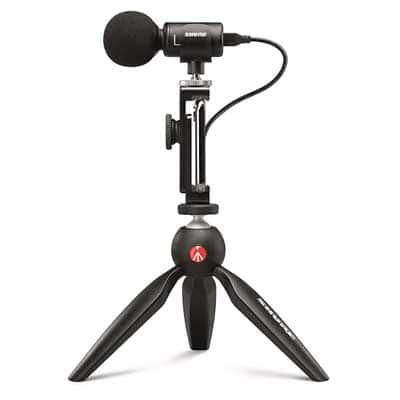Comparison Chart: Best ASMR Microphone
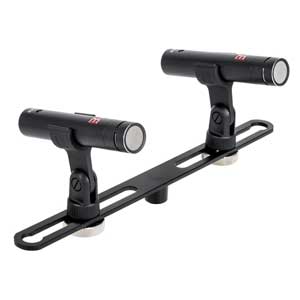
Check Price:
Pros
- Our favorite choice for ASMR
- Great detail resolution
- Delivers above its price point
- Quality build
- Excellent carry case and accessories
Cons
- None
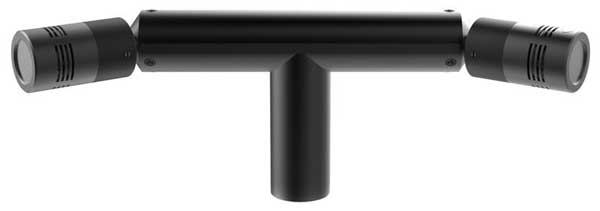
Check Price:
Pros
- Very good sound for the price
- Included carry case, cable, and shockmount
Cons
- Poor build quality
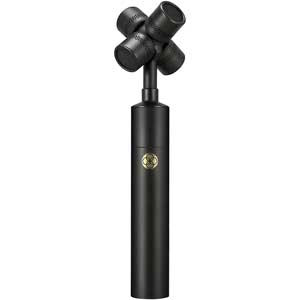
Check Price:
Pros
- 360 surround recording
- Excellent detail resolution
- Premium build
- Excellent included accessories
- Very good free decoding plug-in
Cons
- Requires 4 matched XLR inputs on your audio interface or a recorder that can record in ambisonic A-format, or AmbiX.
- Pricey
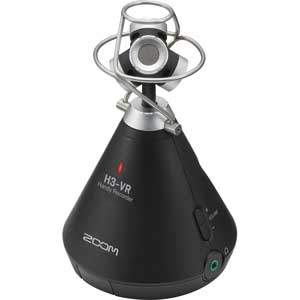
Check Price:
Pros
- 360 surround recording
- No need for an audio interface
- Portable
- Ambisonic recorder, mic, and decoder all-in-one
- Great price
- Simple to operate
Cons
- Delicate
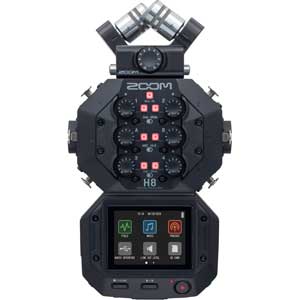
Check Price:
Pros
- Portable recorder that doubles as audio interface
- 12-track simultaneous recording
- Good onboard mics
- Good amount of gain from the preamps
- Expandable
Cons
- Does not support ambisonic formats
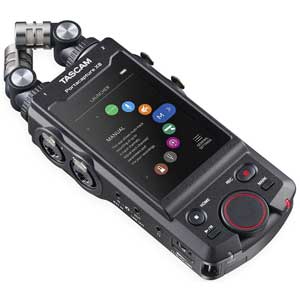
Check Price:
Pros
- Portable recorder that doubles as audio interface
- 8-track simultaneous recording
- Large, bright LCD screen
- Solid preamps
Cons
- Does not support ambisonic formats
- Battery drains quickly
- Mediocre onboard mics
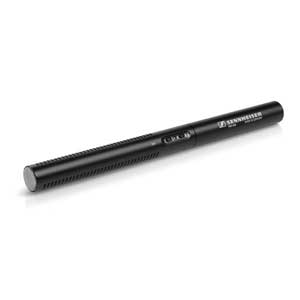
Check Price:
Pros
- Great for isolating sound from a single source
- Good Price
- Very good sound for dialogue and louder action
- Fantastic at rejecting neighboring noise
Cons
- Not ideal for intimate sounds due to self-noise
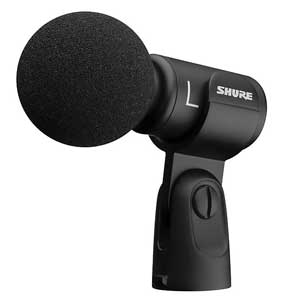
Check Price:
Pros
- No need for an audio interface
- Very good sound for a phone-powered mic
- MOTIV App is easy to use and works with Android and IOS
Cons
- A little bit noisy
A Brief Introduciton to ASMR Audio
If you’re new to the bizarre, stimulating world of ASMR videos, you’re in for a ride. For creators of ASMR in search of the best audio solutions, you’ve come to the right place.
ASMR, short for Autonomous Sensory Meridian Response, is a phenomenon characterized by tingling sensations and a mild sense of euphoria triggered by specific audio and visual stimuli.
Common ASMR audio triggers include: blowing, whispering, scratching, cat purring, crinkling, typing, page turning, sticky sounds, water sounds. The triggers tend to occur primarily in mid to high frequencies.
Check out this post for some tips on how to enhance ASMR audio triggers.
The Mics We Selected for Review and Why
Not all ASMR projects are the same. Some require an immersive experience that only an ambisonic mic can provide, while other projects might demand a single shotgun mic or a field recording mic you can use with your phone.
For this buyer’s guide, we reviewed the following mics:
- SE Electronics SE8 matched pair, small-diaphragm condenser mics, and the Superlux S502MKII, a T-shaped stereo mic – two options for a stereo array. – two options for a stereo array.
- Rode NT-SF1 – an ambisonic microphone
- Zoom H3-VR – an ambisonic mic and portable recorder
- Tascam Portacapture X8, Zoom H8 – portable recorders with preamps and different detachable mics
- Shure MV88+ – a field recording mic that can be used with any Andriod or IOS phone
- Sennheiser MKE 600 – a small-diaphragm shotgun-style mic
These mics were shortlisted and selected for review to provide an option for any budget. This list should also give you a wide range of sonic options for your ASMR project. We will discuss the advantages and disadvantages of each mic for specific applications.
All of these mics use small-diaphragm condenser capsules. (See here for information on mic types and how they work) Small-diaphragm condenser mics are best at picking up high-frequency detail and tend to deliver the most natural sound.
If you want a larger-than-life sound, you might try a large-diaphragm condenser mic using cardioid or omni polar pattern. An AKG C414 XLII or a Rode NT2-A would be great mics for this purpose, used alone or as a matched pair.
See here for all our reviews and information about mics and other audio gear.
Our ASMR Test Video
To find the right ASMR mic, we had to make ASMR! You can hear all the mics in action in the video below. Unfortunately the full effect of the ambisonic mics cannot be experienced here as this video had to be mixed down to Dolby 5.1 Surround.
We highly recommend listening with headphones with the video set to the highest quality. See here to find the best headphones for ASMR listening.
Our Top Choice for ASMR
SE Electronics SE8
our rating
4.9
Check Price:
Bottom Line:
One of our favourites on this list for ASMR. Pencil mics that deliver above their price point.
The SE Electronics SE8 matched pair were our favorite performers in our ASMR tests.
The SE8s are your standard pencil-shaped, small-diaphragm condenser mics. They come with attenuation pads (-10 and -20 dB) and a low-cut filter. The innards consist of a half-inch gold-sputtered diaphragms which are handmade in the Shanghai factory
The frequency response of the SE8 is flat with a tiny presence peak from 5-8 kHz.
The SE8 mics are available as individual mics or as matched pairs. A stereo image adds depth to your sound, bringing to life your spine-tingling ASMR audio. That said, a single SE8 mic would also work well on its own.
The included accessories are excellent: an aluminum carry case with stand clips, a stereo bar, and two foam windscreens. The build quality of all the materials is premium.
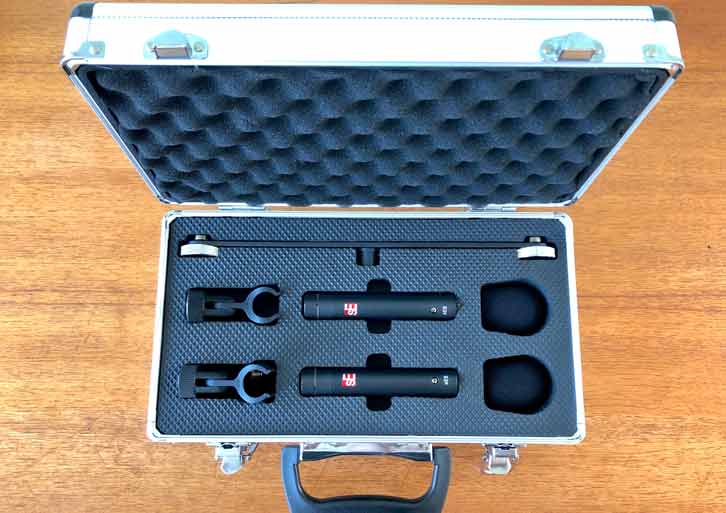
Conclusions About the SE Electronics SE8 Matched Pair
We loved the sound of these little guys in our tests. They are sort of a poor man’s version of the Beyerdynamic MC930, which are some of our favorite small-diaphragm condensers.
They do what they are supposed to do: they excel at picking up high-frequency detail and quick transients, and the polar pattern is consistent, even off-axis.
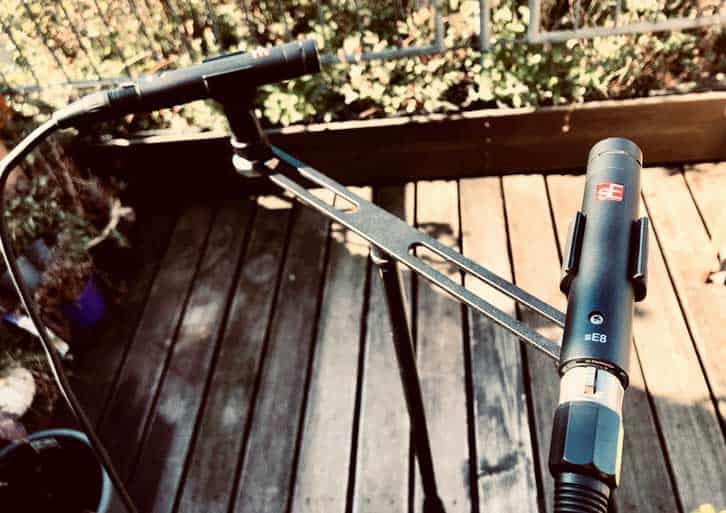
The SE8 picked up more detail than any of the other stereo options we tried, and the self-noise (13 dB) was lower than that of the other mics. For miking ASMR, the SE8 will serve you well.
Superlux S502MKII
our rating
4.3
Check Price:
Bottom Line:
Good sound at a low price. Poor build quality.
Superlux S502MKII: Notable Specs for ASMR
- Polar pattern: Stereo pair, cardioid
- Max SPL: 134 dB
- Frequency Response: 40 – 20 kHz
- Self-noise: 15 dB
The Superlux S502MKII is a T-shaped stereo microphone with two small diaphragm mics in a fixed ORTF stereo position. (Cardioid mics spread at a 110° angle, spaced 17 cm apart)
The Superlux S502MKII is the latest incarnation of the S502. Superlux has changed some of the build materials and lowered the self-noise by about 3 dB.
The mic comes with a hardshell carry case, shockmount, cable, and two foam windscreens. Although all the accessories are appreciated, the build quality is poor. The foam padding, windscreens, and cable are unfortunately not built to last.
The frequency response of the mics is very neutral, with a slight presence peak at 10 kHz.
Conclusions About the Superlux S502MKII
In spite of the poor build quality, we liked the Superlux S502MKII as a stereo mic option for ASMR. They have less detail and more noise than the SE Electronics SE8 pair, but they offer very good sound and lower noise than most entry-level small-diaphragm condensers.
The longevity of this mic is questionable, but it does deliver good sound at a low price.
Rode NT-SF1
our rating
4.6
Check Price:
Bottom Line:
Ambisonic mic with excellent detail resolution and a premium build.
Ambisonic microphones record 360˚ audio in the most advanced format available today. The results can be mixed down into any surround, stereo or mono format you like, including binaural audio, and Dolby surround.
There was a time when ambisonic microphones were out-of-reach price-wise for most freelance creators. Now, there are two high-quality, ambisonic mics on the market that are priced about 1/3 the cost of their predecessors: the Rode NT-SF1 and the Sennheiser Ambeo VR.
Unfortunately, we were not able to get a hold of the Sennheiser Ambeo VR for this review.
The NT-SF1 is four small-diaphragm condenser mics in a tetrahedral configuration. The mic can describe any three-dimensional world from a particular point in space, bringing any ASMR recording to life.
The NT-SF1 comes with a spherical windshield, a furry (another windshield with a funny name), a shockmount, and a 3-meter cable terminating in four color-coded, male XLR outputs. There is notably no carry case included.
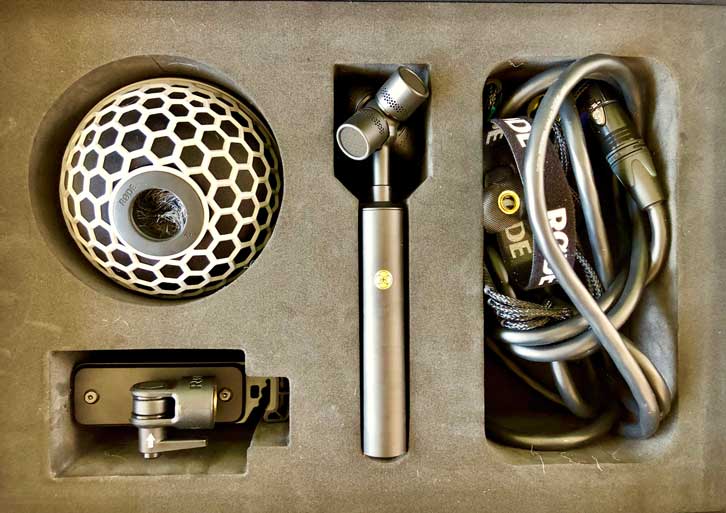
In addition to producing 360˚ surround ambisonic recordings, ambisonic mics like the NT-SF1 can use their output to simulate any mono or stereo array, and this can all be adjusted AFTER recording.
This allows the creator to focus a recording on a particular sound source, and mix down in Ambisonics, Binaural, or Dolby Surround. The creative possibilities go far beyond what is possible with a conventional stereo setup.
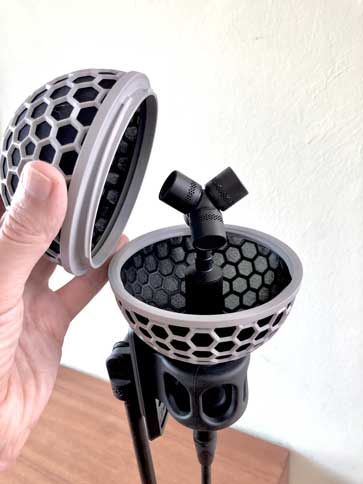
The processing of the four signals from the NT-SF1 are decoded by the free Rode plug-in, Soundfield by Rode. This is relatively easy to operate and can be used with most popular DAWs. (See our post on The Best DAWs | What Each DAW is Best At for more info)
To operate the NT-SF1, you will need an audio interface capable with four available matched preamps or ideally a portable recorder that supports ambisonic recordings.
A Note about Recording with Ambisonic Audio
To record ambisonic or surround audio as your video soundtrack, you will need four balanced XLR inputs on your audio interface and a DAW (We know Logic Pro X, Reaper, and ProTools work) and video editing software that supports ambisonic audio. (We know Adobe Premier works, Final Cut Pro does not)
If you’re shooting and moving, you’ll need a portable recorder like the Tascam DR-701D or the Zoom F6 that has at least 4 XLR inputs and is capable of recording in Ambisonic-A, or AmbiX format.
Conclusions About the NT-SF1
Overall, we found the NT-SF1 to be exactly as advertised, a quality ambisonic mic with high-detail resolution. The build quality of the mic and all the accessories is premium.
The mixing possibilities with this mic are endless. That might be its greatest strength and weakness. A stereo array is much easier to record and mix. But on the whole, we loved the results of the NT-SF1 and were sad to send it back.
Zoom H3-VR
our rating
4.5
Check Price:
Bottom Line:
Ambisonic audio without a steep price tag.
Zoom H3-VR Notable Specs for ASMR
- Four built-in small-diaphragm condenser mics in a tetrahedral configuration for ambisonic recording.
- Onboard ambisonic A to B decoding
- Three recording modes: ambisonics, stereo binaural, or standard stereo
- Headphone output and line output (to camera)
- Slate tone/sound marker for easy calibration with video
- Wireless IOS remote control with BTA-1 Bluetooth adapter (sold separately)
- uses 2 AA batteries
- records directly to microSD up to 1 TB
Zoom recently released the Zoom H3-VR, which is an ambisonic mic, recorder, and decoder all-in-one. All of this is at a very aggressive price point (currently priced under USD 250).
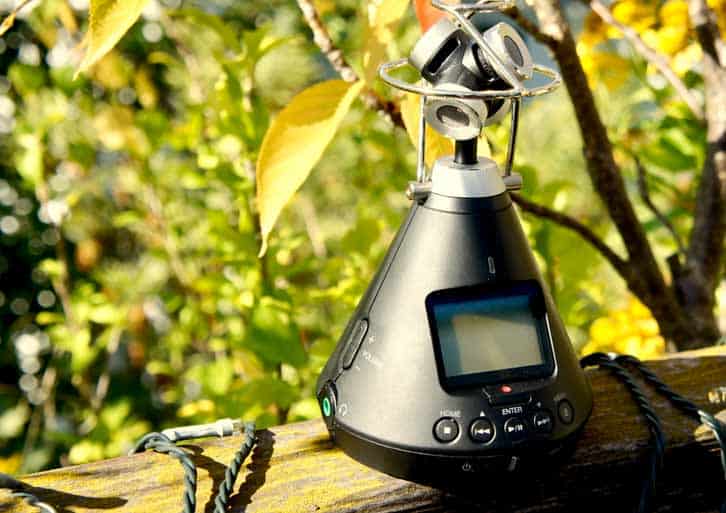
Mixing ambisonic audio can get very complicated. Perhaps the greatest feature of the Zoom H3-VR mic is how straightforward and simplified it is to operate. Just press record and stop.
It records in 360 surround audio, binaural 3D stereo, Standard stereo and 5.1 surround. The format can be adjusted to FuMa, AmbiX (B-format), Ambisonics A, or Stereo. And the Zoom Player software makes it easy to convert these formats in post-production.
If you’ve ever owned a Zoom H-series device you are aware that they are disconcertingly lightweight. The H3-VR is feather-light and feels a bit delicate. A decent carry case would be worth the investment.
Conclusions About the Zoom H3-VR
In general, the Zoom H3-VR delivered very good sound and was very easy to use. The detail resolution and low self-noise are predictably not as impressive as the Rode NT-SF1 or even the other stereo mics.
We still loved it. For anyone who wants to work with ambisonic or surround audio without a steep price tag, this is your machine.
Zoom H8
our rating
4.6
Check Price:
Bottom Line:
A quality, good value portable recorder.
Zoom H8 Notable Specs For ASMR
- Four mic inputs and two XLR/TRS combo inputs
- secondary minijack input
- Phantom power (24V/48V) for all six XLR inputs
- Records directly onto SD, SDHC, and SDXC cards up to 512 GB
- 10 hours of operation on 4AA alkaline batteries
- 12-track simultaneous recording
- Doubles as an audio interface
The Zoom H8 is the latest in the H-series from the company. The H8 is a good-sized, portable recorder with modular construction, allowing you to increase its abilities at will.
The modules include additional mic capsules (shotgun, mid-side, etc.), additional XLR inputs (EX-8), or the VRH-8 gives you an ambisonic mic and decoder.
The interface all happens on the 2.4-inch LCD touchscreen on the front of the unit. Also a plus, this screen switches into low-power mode when left untouched to save on battery drain.
The software is separated into separate apps depending on your recording application to get you up and running quickly. We found the interface very easy to use and intuitive.
Conclusions About the Zoom H8
The Zoom H8 is a very capable portable recorder. The preamps provided enough gain to support even high gain mics like the Shure SM7B.
Zoom does not provide figures for self-noise on the pre-amps or the onboard mics. In our tests, the self-noise was much lower than that of the Tascam Portacapture X8 and the detail resolution of the mics was much better than expected.
We liked it more than the Tascam X8 but still falls short of pro machines like the Zoom F6 or Tascam DR-701D. Still, all in all, you’re getting good value with the Zoom H8.
Tascam Portacapture X8
our rating
4.0
Check Price:
Bottom Line:
Nice machine with mediocre onboard mics.
Tascam Portacapture X8: Notable Specs for ASMR
- 2 onboard detachable small-diaphragm condenser mics
- 4 balanced, phantom-powered mic/line inputs
- up to 8 simultaneous recording tracks
- Approximately 11 hours runtime on 4AA alkaline batteries
- Records in 44.1k/48k/96k/192kHz, 16/24-bit, 32-bit float (32-bit float
- ability to add modules for additional capabilities (e.g., Bluetooth, …) allows you to change levels in post-production)
- Dynamic range of onboard mics: 20-20kHz @ 48kHz
- Doubles as an audio interface for Mac or PC
Released in 2022, the Tascam Portacapture X8 is the company’s latest hi-res multitrack handheld recorder. With loads of onboard hardware, built-in DSP, and the ability to add modules, this recorder packs loads of features into one device at a very competitive price.
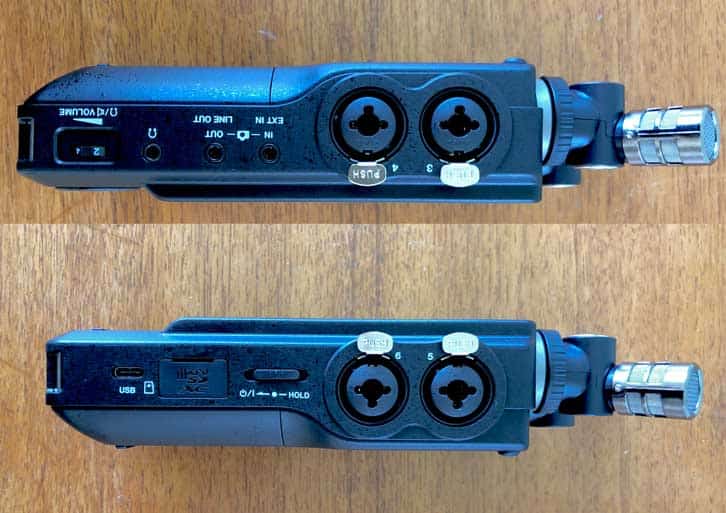
The recorder runs on 4 AA batteries or an external charger and runs on a 3.5-inch color touchscreen. The large screen is much easier to navigate with than the smaller Zoom H8 screen. It is bright and easy to use but it is also most likely what makes this recorder a bit of a battery hog.
Tascam claims that the device lasts 11 hours on alkaline batteries, which I seriously doubt. We began tests using battery power, and soon after, switched to the USB-C power because half the battery life had drained after only a few hours of testing.
The software that runs it has been separated into different apps for specific recording tasks to get you up and running quickly, or the manual mode which allows you access to all available functions. The interface feels intuitive and easy to use.
It is worth noting that if you want to record ambisonic/surround recordings, the Portacapture X8 is not the device you want. You will need something like the Tascam 701-D, which can record in both A and B formats for Ambisonics.
The onboard mics are mediocre quality and a bit noisy. (No self-noise figure is offered by Tascam) They can be configured in A-B or X-Y orientation.
For video applications, the Portacapture X8, the CAMERA/EXT input, and the CAMERA/LINE output allow you to send audio to and from your camera. The cold shoe and tripod connectors allow you to easily mount the Portacapture X8 to your camera.
Conclusions About the Tascam Portacapture X8
The Tascam Portacapture X8 was less impressive than the Zoom H8. The main drawbacks of this machine are the mediocre onboard mics and the battery drain.
In general, however, we found the Tascam Portacapture X8 to be a good piece of gear. That said, I would rather have the Zoom H8 (for better battery life, more versatility, and physical dials for levels) or a pro device like the Tascam DR701-D (for Ambisonics and built-for-video features).
Sennheiser MKE 600
our rating
4.0
Check Price:
Bottom Line:
Very good value shotgun mic. Good for dialogue and louder action, not so great for intimate sounds.
Sennheiser MKE 600: Notable Specs for ASMR
- Polar pattern: super-cardioid (shotgun)
- Frequency response (40 Hz – 20 kHz)
- Power Supply: 48V phantom power or battery
- Self-noise: 15 dB (A) with phantom power; 16 dB (A) with battery power
The MKE 600 is a small-diaphragm condenser shotgun mic giving you the ability to focus your sound on a specific subject. The MKE 600 can be powered with phantom power or battery powered which allows you to connect it directly to most cameras.
It comes with a foam windshield, shockmount, and adapter cable for cameras with a 3.5mm TRS jack.
Shotgun mics like the MKE 600 are ideal for applications where the sound subject is dry and in one place. The supercardioid polar pattern allows for high gain without feedback and minimal unwanted noise.
Conclusions About the Sennheiser MKE 600
The MKE 600 is an excellent value shotgun mic, but it might not be the best choice for ASMR videos. It’s great for dialogue and louder action but it’s a little bit too noisy for intimate sounds like page turning and squishy ASMR-like sounds.
That said, the Sennheiser MKE 600 delivers very good detail resolution and excellent off-axis noise rejection.
If you want a hyper-directional mic with low self-noise, you will need to get a professional-grade shotgun mic Sennheiser MKH 416-P48.
Shure MV88+
our rating
4.6
Check Price:
Bottom Line:
Very good sound for a phone-powered mic.
Shure MV88+: Notable Specs for ASMR
- Polar pattern: Stereo, mono bidirectional, mono cardioid, mid-side
- Works on IOS or Andriod
- Supported Audio: WAV, AAC (up to 256 kHz), MP4 Audio (IOS only)
- frequency response: 20Hz – 20 kHz
For ASMR creators on a budget, the Shure MV88+ is a great option.
Shure’s MV88+ eliminates the need for a portable recorder or computer and allows you to, like almost everything else these days, do it on your phone.
The MV88+ can be purchased by itself or as the MV88+ Video Kit which includes lighting and USB-C cables for connecting to a phone. It also works with an iPad with limited features (gain adjustment only) on the MOTIV App.
Videos can be made directly with the free Shure MOTIV Video App. Sadly, these videos can only be shot in portrait orientation. If you’re working with audio only, the MOTIV Audio App is very easy to use and works as it should.
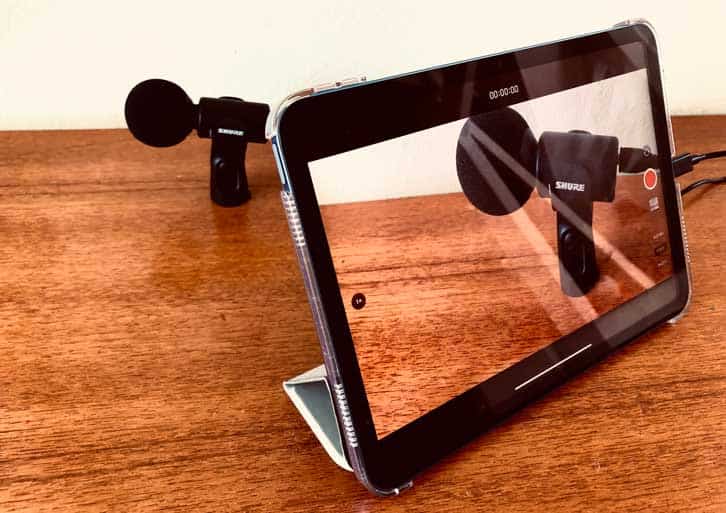
Conclusions about the Shure MV88+
Most USB mics are simply not worth it. The MV88+ is an exception.
Considering this device works without a proper external preamp, the sound of the Shure MV88+ mic is very good. It was a little noisy (Shure provided no self-noise figure in the specs) and the detail was of course, not on the level of the Rode NT-SF1 or SE8 mics.
That said, Shure have succeeded in making a quality mic that can be powered by a phone. That’s no small achievement. On the whole, the MV88+ offers fantastic value and performance for a phone/tablet mic.
Questions or Comments?
Follow the discussion here on Facebook.
